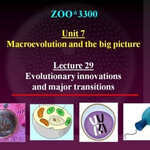Evolution

There are many beneficial aspects to reading and writing blogs about science. I have found that they are often much better than news feeds (which generally are uncritical repetitions of press releases) for learning about research in areas other than my own specialization. This also makes them very useful for teaching, as new examples that otherwise might be overlooked can be found and added to the course material. Case in point, Not Exactly Rocket Science (a blog you should be reading, btw) has a post about a new paper in today's Cell in which yeast behave in a cooperative way if they possess…

A recently discovered female pelvis is changing minds about the head size of an ancient human ancestor, Homo erectus, and consequently revising notions about how smart they may have been. The Pleistocene adult female Homo erectus pelvis was from the Busidima Formation of Gona, Afar, Ethiopia., not far from the site that yielded the 3.2 million year old remains of the famed Australopithecus afarensi "Lucy," and the pelvis indicates that Homo erectus, which lived in Africa roughly 2 million years ago, had a larger birth canal than originally suspected and could have given birth to babies with…

As any good beer brewer knows, the yeast used in fermentation stick together in large clumps consisting of thousands of cells that settle out where they are easily removed. Brewers had even traced this behavior to a gene that encodes a sticky protein that sits on the surface of yeast cells. But despite the fact that yeast are a major laboratory "workhorse," any further exploration of their social lives had remained almost entirely neglected. Indeed, the "domesticated" yeast commonly studied in genetics labs have had any social tendencies bred out of them.
But a new report in the…

My feeling about science news reports is decidedly mixed. On the one hand, I read most of the main news services in order to keep up with research outside of my own discipline. On the other hand, I would say that about once every two or three days I find a story so silly that it makes me physically uncomfortable. This is one of those.
Evolution's new wrinkle: proteins with 'cruise control' act like adaptive machines
It opens:
A team of Princeton University scientists has discovered that chains of proteins found in most living organisms act like adaptive machines, possessing the ability to…

A team of Princeton University scientists say they have discovered that chains of proteins found in most living organisms act like adaptive machines, possessing the ability to control their own evolution. They say the research appears to offer evidence of a hidden mechanism guiding the way biological organisms respond to the forces of natural selection and provides a new perspective on evolution, the scientists said.
The researchers -- Raj Chakrabarti, Herschel Rabitz, Stacey Springs and George McLendon -- made the discovery while carrying out experiments on proteins constituting the…

There are no coincidences...yup, I had to laugh after signing up for this blog a couple minutes ago. In my description I wrote that curiosity killed the cat and that's why they have nine lives. To collect as much data to use for the next 'trip'. Then after you sign up you're brought to the 'rules' page...here's what made me laugh:2. Who can write here? - Most of our writers are prominent book authors, professors and post-docs but anyone can write here. The only restriction is you have to write about science. We don't get into defining what is science and what isn't…

Small skink lizards, Lerista, demonstrate extensive changes in body shape over geologically brief periods. Research published in the open access journal BMC Evolutionary Biology shows that several species of these skinks have rapidly evolved an elongate, limbless body form.
Skinks are a common sight in Australia and many species have limbs that are either reduced or missing entirely. According to the lead author of this study, Adam Skinner of The University of Adelaide, "It is believed that skinks are losing their limbs because they spend most of their lives swimming through sand or…

OK, so you all know that Spore isn't based on how evolution actually works. There has been some concern that playing the game would cause players to develop a faulty understanding of evolution.
So I was pleasantly surprised tonight at my 8 year-old's response (completely unprompted, honest!) when I read her the following:
How does life change over time, and how did all those different forms of life come to be?... [Evolution] is the result of tiny changes adding up to bigger changes. These changes happen deep inside the cells of every living thing - in the genes, the instructions that make…

Why are some species of plants and animals favored by natural selection? According to a UC Riverside-led research team, the answer lies in the rate of metabolism of a species – how fast a species consumes energy, per unit mass, per unit time. The researchers studied 3006 species, the largest number of species ever analyzed in a single study. The species list encompasses much of the range of biological diversity on Earth – from bacteria to elephants, and algae to sapling trees.
To the researchers' surprise, they found the mean metabolic rate of the species at rest fell on a…

Researchers in Spain writing in the Journal of Proteome Research report deep new insights into how evolution changes the biochemistry of living things, helping them to adapt to new environments. Their study, based on an analysis of proteins produced by two populations of marine snails, reveals chemical differences that give one population a survival-of-the fittest edge for life in its cold, wave-exposed environment.
In the new study, Emilio Rolán-Alvarez and colleagues note that scientists long have known that animals of the same species can have different physical characteristics enabling…